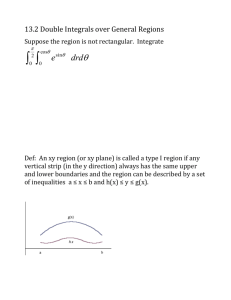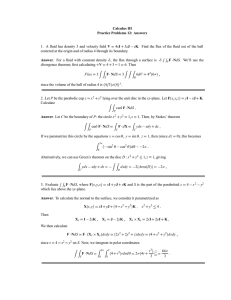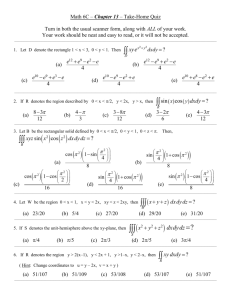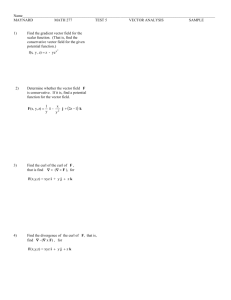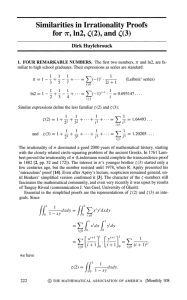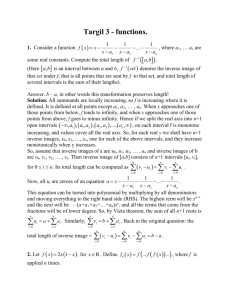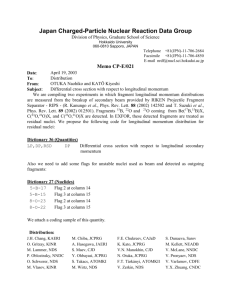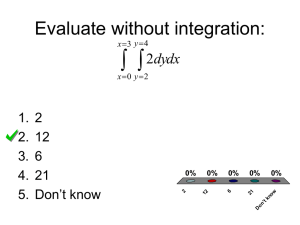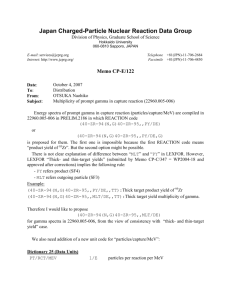The divergence theorem
advertisement
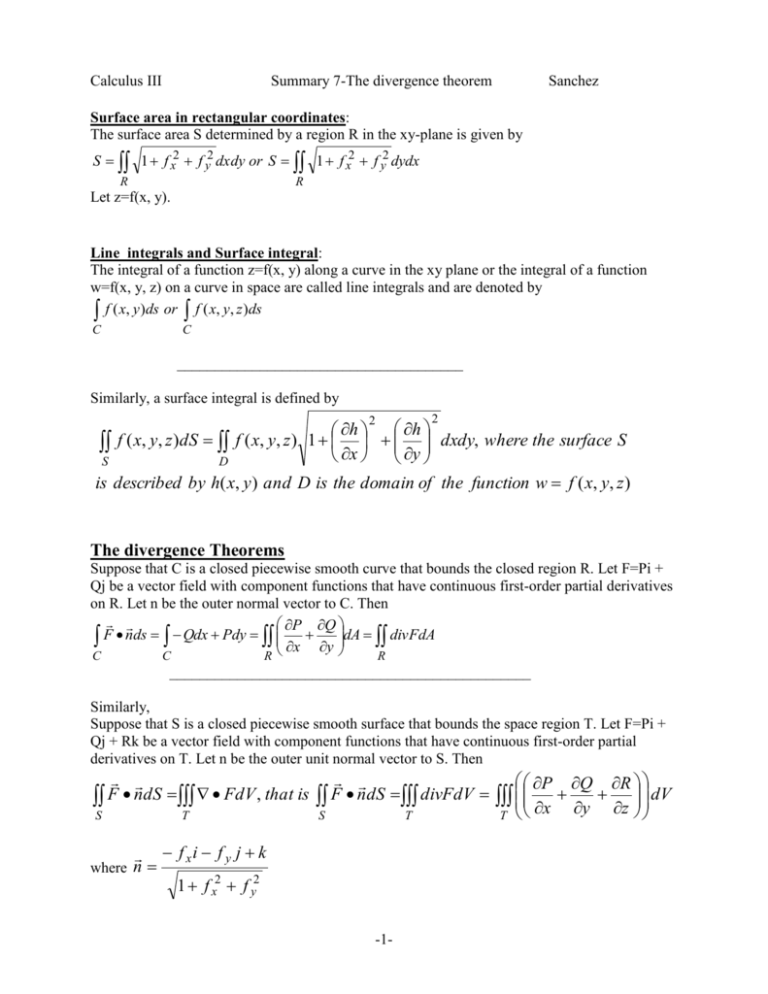
Calculus III Summary 7-The divergence theorem Sanchez Surface area in rectangular coordinates: The surface area S determined by a region R in the xy-plane is given by S 1 f x2 f y2 dxdy or S 1 f x2 f y2 dydx R R Let z=f(x, y). Line integrals and Surface integral: The integral of a function z=f(x, y) along a curve in the xy plane or the integral of a function w=f(x, y, z) on a curve in space are called line integrals and are denoted by f ( x, y)ds or f ( x, y, z)ds C C ______________________________________ Similarly, a surface integral is defined by 2 2 h h f ( x, y, z )dS f ( x, y, z ) 1 x y dxdy, where the surface S S D is described by h( x, y ) and D is the domain of the function w f ( x, y, z ) The divergence Theorems Suppose that C is a closed piecewise smooth curve that bounds the closed region R. Let F=Pi + Qj be a vector field with component functions that have continuous first-order partial derivatives on R. Let n be the outer normal vector to C. Then P Q F nds Qdx Pdy x y dA divFdA C C R R ________________________________________________ Similarly, Suppose that S is a closed piecewise smooth surface that bounds the space region T. Let F=Pi + Qj + Rk be a vector field with component functions that have continuous first-order partial derivatives on T. Let n be the outer unit normal vector to S. Then F ndS FdV , that is F ndS divFdV S S T where n T f xi f y j k 1 f x2 f y2 -1- P Q R x y z dV T Problem 1: Evaluate the surface integral f ( x, y, z )dS if f(x, y, z)=x+y and S is the first octant part of the plane x+y+z=1 2 2 h h f ( x , y , z ) dS f ( x , y , z ) 1 dxdy, where the surface S x y S D is described by h( x, y ) and D is the domain of the function w f ( x, y, z ) z 1 x y x y 1in the xy plane 1 1 y x y dS x y S 0 0 1 y 1 x2 3 xy 0 2 0 1 1 y 1 (1) (1) dxdy 3 2 2 ( x y )dxdy 0 0 1 1 1 y 2 1 2y y2 2y 2y2 dy 3 (1 y ) y dy 3 dy 2 2 0 0 1 31 3 y 3 3 1 3 2 3 2 1 y dy y 1 2 0 2 3 2 3 2 3 3 0 Problem 2 Calculate FdV where F=xi + 2yj + 3zk and T is the space region with boundaries S T given by the first octant cube with opposite vertices (0, 0, 0) and (1, 1, 1) Z Y x 111 P Q R FdV divFdV x y z dV 1 2 3dxdydz T T T 000 111 6 dxdydz 6(1 1 1) 6 000 -2- Problem 3. Calculate the outward flux of the vector field F=xi + 2yj +3zk across the surface S given by the boundary of the first octant cube with opposite vertices (0, 0 ,0) and (1, 1, 1). z S3 S6 S2 S1 S5 S4 y S1: left face S2: right face S3: top face S4: bottom face S5: front face S6: back face x F ndS S F ndS F n dS F ndS F n dS F ndS F ndS S1 S2 S4 S6 S3 S5 y 0 F n dS ( xi 2 yj 3 zk ) j dxdz 1 1 S1 S1 F n2 dS2 ( xi 2 yj 3zk ) j dxdz S2 S2 F n3 dS3 ( xi 2 yj 3zk ) k dxdy S3 S3 11 11 00 y 1 1 1 00 11 (2ydxdz 0dxdz 0 (2ydxdz 2 dxdz 2 00 z 1 1 1 00 11 (3zdxdy 3 dxdy 3 00 F n3 dS3 ( xi 2 yj 3zk ) k dxdy S4 S4 F n5 dS5 ( xi 2 yj 3zk ) i dydz S5 S4 00 z 0 1 1 11 00 00 (3zdxdy 0 dxdy 0 x 1 1 1 F n5 dS5 ( xi 2 yj 3zk ) i dydz S6 S6 11 ( xdydz dydz 1 00 x 0 1 1 00 ( xdydz 0 dydz 0 00 Therefore, F ndS 0 2 3 0 1 0 6 divFdV S T Problems 2 and 3 verify the Divergence Theorem. -3- 11 00 Problem 4. Verify the divergence theorem if F=(x + y)i + (y + z)j +(x + z)k and S is the surface of the tetrahedron bounded by the three coordinate planes and the plane x + y + z =1 z S1: left triangle, n1 =-j S2: back triangle, n2=-i y+z=1 x+z=1 y S3: bottom triangle, n3=-k x+y=1 x S4:triangle determined by the plane x+y+z=1, n4=i+j+k which is the normal to the plane. F n dS F ndS F n dS F ndS S S2 S1 S3 y 0 F n1dS1 ((x y)i (y z)j (x z)k ) j dxdz 11 S1 00 S1 zdxdz z (1 z )dz 1 1 z 1 1 0 0 0 0 1 z3 z2 1 2 z z dz 2 0 6 3 F n2 dS2 ((x y)i (y z)j (x z)k ) i dxdz S2 S2 x 0 1 1 (x y )dydz 00 ydydz z (1 z )dz 1 1 z 1 1 0 0 0 0 ( y z )dxdz 1 z3 z2 1 z z dz 2 0 6 3 2 z 0 1 1 F n3 dS3 ((x y)i (y z)j (x z)k ) k dxdy (x z )dxdy S3 S2 00 xdydz y (1 y )dy 1 1 y 1 1 0 0 0 0 -4- 1 y3 y2 1 y y dy 2 0 6 3 2 Problem 4 (continuation) z 1 x y i j k F n dS ((x y)i (y z)j (x z)k ) 1 1 1 dxdy 3 3 3 S4 S4 1 1 y 1 y 2 2 x 2 y 2 z dxdy 2 dxdy 2 (1 y )dy 2 y 1 2 S4 0 0 0 0 1 1 1 1 1 Therefore, F ndS 1 1 6 6 6 2 2 S 1 1 1 x 1 x y divFdV 1 1 1dV 3 T T 0 0 1 x 1 1 x dzdydx 3 0 (1 x y )dydx 0 0 1 y 2 1 x 2 3 y xy dx 3 1 x x(1 x) 2 dx 2 0 0 0 1 2 2x 2x 2x 2 1 2x x 2 31 3 dx 1 2 x x 2 dx 2 20 0 1 1 31 3 (1 x) 3 1 1 1 x 2 dx 0 1 20 2 3 01 2 2 Therefore, F n dS divFdV which verifies the convergence theorem. S T Problem 5. Verify the Divergence theorem in the evaluation of F ndS for the solid S x y 4 , z 0 and z 2 if F 3xi y j 3z k 2 2 divF 2 P Q R 3 2 y 6z x y z 2 F ndS divFdV 4 S T 4 x 2 2 0 2 4 x 2 (3 2 y 6 z )dzdydx 4 0 0 0 2 6 4 y 12 dydx 4 18 y 2 y 4 x 2 4 0 2 2 0 2 72 0 2 4 x dx 84 x 2 0 2 2 0 4 x 0 2 2 2 dx 8 9 4 x 2 4 x 2 dx 72( ) 8(0) 72 -5- 2 0 3z 2 yz 3z 0 0 dydx Problem 5 (continuation) F n dS F n dS F n dS F 1 2 ndS 3 S S1 S2 S3 S1 : is the circular base of the cylinder , n1 k , z 0 S 2 : is the circular top face of the cylinder , n 2 k , z 2 S 3 : is the lateral surface of the cylinder The vector xi yj 0k is normal to the cylinder x 2 y 2 4, n3 xi yj ok x2 y2 2 1 4 x 2 z 0 1 4 x 2 2 2 F ndS1 3xi y j 3z k k dS1 4 3z dydx 4 12 0dydx 0 S1 S 0 0 0 0 1 4 x 2 z 2 1 4 x 2 2 2 F ndS 2 3xi y j 3z k k dS1 4 3z dydx 4 12 dydx 48 S2 2 S 0 0 0 0 y j i f j f k i y z For S 3 , Let x f ( y, z ) 4 y 2 0 z , then n 4 x 2 2 2 1 f y f k y 1 x2 3x 2 y 3 xi yj ok 2 2 F n dS 3 xi y j 3 z k dS 2 2 2 2 2 x y S2 S S x y 2 2 2 2 2 3x 2 y 3 x dzdy 2 2 0 /2 4 12 3 y 2 y 3 4 y 2 0 12 12 sin 2 8 sin 3 4 4 sin 2 / 2 /2 2 2 dzdy 4 12 3 y 2 y 3 2 2 cos d 4 1 /2 4 y 2 y2 x2 yk xi x2 y2 dzdy dy 1 cos 2 2 (12 12 8 1 cos sin d 2 / 2 /2 3 8 cos 3 4 [6 6 cos 2 8 1 cos sin ]d 46 sin 2 8 cos 2 3 / 2 / 2 24 Therefore 2 F ndS F ndS1 F ndS 2 F ndS 3 0 48 24 72 S S1 S2 S3 Therefore, the divergencetheorem is verified -6-
